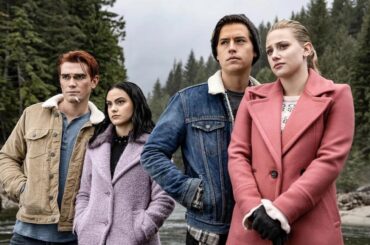Ted is a nice and quick half-hour comedy. It’s easy-breezy, even at its crudest, and simply entertains. Behind the show’s vibrancy is cinematographer Jeffrey C. Mygatt, who previously worked with showrunner Seth MacFarlane on The Orville.
Mygatt has shot his fair share of thrillers in the past, including many episodes of Prison Break, 24: Legacy, and Designated Survivor. With MacFarlane, the DP continues to show his range with the Peacock comedy. Recently, Mygatt spoke with Immersive Media about the technical choices behind Ted.
What cameras did you shoot Ted on?
The Venice.
What made you go with the Venice?
It’s a long story, but I was doing a show called What If for Netflix, and I had been using the Mini for years. Netflix says it has to be 4K, so the 3.2K won’t work. You have to shoot 4K. The LF was coming out, the Alexa LF, and it wasn’t actually on the market yet. I asked a couple of the engineers at the rental house, “Will the lenses that I use normally fit on this camera and work?” They said, “Oh yeah, not a problem.” So, I said, “Okay, we’ll have three of those cameras.” Day one of prep, my assistants called and said, “All these lenses are vignetting.” I said, “What do you mean?” He goes, “You have to zoom in on the 15 to 40. You have to zoom into 27 before it doesn’t vignette anymore.”
So, of course, I raced down to the rental house. They showed me, I talked to their lens engineer, and he goes, “No, that’s the way it is. There are no zoom lenses that cover the 4K sensor.” I was like, “Okay, well, that doesn’t help because that’s how I’m able to make my day. If I don’t have a zoom lens on a camera when the director goes, ‘Oh, I just want to be five mils tighter,’ most lenses, you go from a 25, you go to a 32. Well, now you’re either backing the dolly up or moving the dolly in, which takes time. Whereas if I just zoom in three mils or four mils, he goes, ‘Oh, that’s perfect.'”
That enables me to quickly move through things, and I haven’t had a colorist yet say that the zoom lenses I use don’t look as good as the primes. They may not be as crisp, but we’re trying to get away from crispness anyway. We’re always putting softening filters in the cameras, always trying to soften up the image a little bit. So, if you have a really crisp image, now you’re having to add more filtration to knock it down.
So, I went to the rental house and said, “Okay, the Sony Venice just came out. Get one of those down here.” The engineer said, “Well, that won’t make a difference.” I said, “Well, yeah, but I’m one of those people that you have to prove it to me. You have to show it to me that it won’t work.” The camera came in, and I’ve been using Sony cameras since I started in the industry, so I knew all the menus, I knew where they were at.
I just changed from 8K to 4K as an output. What the Sony Venice does is cut into the chip. So, if 8K is here and 6K is here, well, 4K is there. When you put it as a 4K recording, it just punches in on the chip, which means you don’t have a vignette anymore. So, of course, I told the rental house to get me three Venices, and my guys had a day and a half of prep left. It was a little stressful for them.
Why did you want to get away from the crispness?
When digital imaging started, when everybody was switching from film to using a digital camera, they all said, “Well, it’s too sharp, it’s too crisp. It doesn’t look cinematic.” So, we needed to soften it a little bit, take the edges off everything to make it look better. Because if you look at a feature film that’s shot on film, it doesn’t have that. You can see every pore on somebody’s face.
As a cinematographer who started in film and understood video, I’ve been doing video since I was eight years old. The high school I went to had a full TV studio in ’73, so I understood black and white. I understood how to read a waveform monitor, how to work with video and the problems of it back then. Now you can point at a bright light, and it won’t hurt the camera. Back then, if you pointed at a bright light, you’d need a new camera. You just ruined it.
So, producers and directors would say, “Every single pore on her face is too sharp. Now we’re going to have to soften it in post.” Okay, well, that’s easy to do in post now. The last couple of shows I’ve done, I haven’t put filters on with an agreement from visual effects and post that we will soften scenes as needed. They all agreed, and we did. We would put just a light softening filter on in post to take the edge off of it.
How did you and Seth first connect just as collaborators? What conversations did you both have where you kind of knew this person speaks the same visual language?
I came into The Orville in season three, and it was really interesting because we were, I think it was the first week, and we were doing a shuttle. We were on one of the shuttles, and Seth said, “It’s not working. It’s not working.” I asked, “Okay, what are you looking for?” He said, “Well, I want it to do this.” “Oh, okay.” Then I went and talked to the operator, came back, and he said, “No, no, it’s not working.”
Then he stood up and said, “We’ve been doing it for two years, folks. Why can’t we do this now?” I turned and looked at him and said, “Seth, this is the first time I’ve been on the show, and this is the first time that two of the other operators have been on the show. So there’s a little bit of a learning curve.” He said, “Oh, yeah, you’re right. Okay.”
Then he went into a little more detail instead of just saying, “Do this.” Over the course, season three took two, almost three years to film because of COVID. We got to learn. I learned how to deal with Seth, how to talk to him, how to get the answers out of him. If you just listen to him, he explains it. He really does.
So, I would sit there and listen and go, “Okay.” If I had a question, I’d ask him, and he’d draw a picture or point out something. I’d go, “Okay, that’s fine. We can do that.” Another thing with Seth was he didn’t like people who didn’t tell him the truth. So, if he said, “Can you do it in 20 minutes?” and I couldn’t, I’d say, “No, that’s going to take longer.” “Okay, well, what can you do in 20 minutes?” “Well, I can do this.” He’d say, “Okay, let’s do that because that’ll finish that shot.” It’s just communicating with him and letting him know that what you’re saying is true. So, when we did 15-minute turnarounds, day one was supposed to be a 12-hour day, we finished in 10.
From then on, he’d come to me and say, “Okay, I need to be out by this time.” “Not a problem.” I’d look at what we had to do that day and go, “Yeah, we can do that.” There were days that they made it heavy, and I went to the AD and said, “We’re not finishing this day.” “Oh yeah, we will.” I said, “No, we’re not going to finish this day.”
Lo and behold, by the end of the day, they were going, “Okay, that last scene we’re not going to do today,” because I’ve been doing it long enough that I know how much coverage you have. If you have two people in the scene, it can be an eight-page scene. You can finish that in a couple of hours. If you have eight people sitting around a table and each person has dialogue, that’s going to take you all day. That’s just the physics of it because they want all the coverage.
The 12-hour day you got done in 10, how did you do that?
One, because we had all the lighting in place, we knew where all the lights needed to be, and only needed minor adjustments, which only took 10 or 15 minutes. The operators knew what their job was, and we would just hammer down. We would always go to the next shot to the easiest one. So, we do a masters.
If you need the coverage of Matt sitting at the head table and we’re in the living room looking into the dining room, the quickest is to move in on Matt instead of ripping everything out and turning around on somebody else. We always went in progression of what was the most efficient way to shoot the scene because you had to cover it all anyway, so why not go in the most efficient way?
Do you ever miss shooting on film or video?
Well, I still shoot on video because HD is video, no matter how you look at it. One of the first interviews I went on when they were just starting to do HD, a producer said, “Have you ever shot HD before?” I said, “Yeah, I’ve shot video most of my career.” He goes, “No, I mean HD.” I said, “They’re the same thing. It’s an electronic image recorded on a medium. That’s a video. Just because you renamed it HD doesn’t mean it’s any different.” So, of course, I didn’t get the job, but that’s irrelevant.
Yeah, there’s something about shooting on film, but I’ll tell you, at night shooting HD, you know exactly what you’re getting. There’s no guessing on whether the film sensitivity is enough to see the background here. You can take a spot meter and do it for 30 years and say, “Okay, this should be here.” But it never fails; you get a scene that you come into on the dailies and you go, “Ah, the trees are a stop too bright.” Well, now with HD, you know exactly because what you’re seeing is what you’re getting. I have a waveform right next to my monitor, and I know how to read it. I know exactly where everything’s sitting. So, the end product is exactly what I shot, not something they had to really go in and fix.
Ted is available to stream on Peacock.





